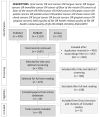Health-Related Quality of Life in Oral Cancer Patients: Scoping Review and Critical Appraisal of Investigated Determinants
- PMID: 34503208
- PMCID: PMC8431462
- DOI: 10.3390/cancers13174398
Health-Related Quality of Life in Oral Cancer Patients: Scoping Review and Critical Appraisal of Investigated Determinants
Abstract
Background: health-related quality of life (HRQOL) represents a secondary endpoint of medical interventions in oncological patients. Our aim was to highlight potential sources of bias that could be encountered when evaluating HRQOL in oral cancer patients.
Methods: this review followed PRISMA-ScR recommendations.
Participants: patients treated for oral cancer.
Concept: HRQOL assessed by EORTC QLQ-C30 and QLQ-H&N35/QLQ-H&N43. A critical appraisal of included studies was performed to evaluate the accuracy of data stratification with respect to HRQOL determinants.
Results: overall, 30 studies met the inclusion criteria, totaling 1833 patients. In total, 8 sociodemographic (SDG) and 15 disease/treatment-specific (DT) HRQOL determinants (independent variables) were identified. The mean number of the independent variables was 6.1 (SD, 4.3)-5.0 (SD, 4.0) DT-related and 1.1 (SD, 1.8) SDG-related variables per article. None of the included papers considered all the identified determinants simultaneously.
Conclusions: a substantial lack of evidence regarding HRQOL determinants was demonstrated. This strongly weakens the reliability of the reported findings due to the challenging presence of baseline confounding, selection, and omitted variable biases. The proposed approach recommends the use of further evaluation tools that gather more variables in a single score together with a selection of more homogeneous, reproducible, and comparable cohorts based on the identified baseline confounding.
Keywords: HRQOL; head; neck; oncology; oral cancer; quality of life.
Conflict of interest statement
The authors declare no conflict of interest.
Figures






Similar articles
-
Psychometric evaluation of Azeri version of the head and neck cancer specific quality of life questionnaire (EORTC QLQ-H&N43).Health Qual Life Outcomes. 2020 Jul 23;18(1):248. doi: 10.1186/s12955-020-01500-2. Health Qual Life Outcomes. 2020. PMID: 32703297 Free PMC article.
-
Patients' experience of recurrent/metastatic head and neck squamous cell carcinoma and their perspective on the EORTC QLQ-C30 and QLQ-H&N35 questionnaires: a qualitative study.J Patient Rep Outcomes. 2018 Aug 1;2:33. doi: 10.1186/s41687-018-0060-7. eCollection 2017. J Patient Rep Outcomes. 2018. PMID: 30148250 Free PMC article.
-
Does palliative chemotherapy really palliate and are we measuring it correctly? A mixed methods longitudinal study of health related quality of life in advanced soft tissue sarcoma.PLoS One. 2019 Sep 26;14(9):e0210731. doi: 10.1371/journal.pone.0210731. eCollection 2019. PLoS One. 2019. PMID: 31557183 Free PMC article.
-
Health-related quality of life in breast cancer patients in Asia: A meta-analysis and systematic review.Front Oncol. 2022 Sep 28;12:954179. doi: 10.3389/fonc.2022.954179. eCollection 2022. Front Oncol. 2022. PMID: 36249065 Free PMC article.
-
The EORTC QLQ-C30 Summary Score as Prognostic Factor for Survival of Patients with Cancer in the "Real-World": Results from the Population-Based PROFILES Registry.Oncologist. 2020 Apr;25(4):e722-e732. doi: 10.1634/theoncologist.2019-0348. Epub 2019 Oct 31. Oncologist. 2020. PMID: 32297435 Free PMC article. Review.
Cited by
-
Questionnaire-Based Assessment of the Masticatory Function and Facial Nerve Recovery Post Pterional Approach in Brain Tumors Surgery.J Clin Med. 2021 Dec 23;11(1):65. doi: 10.3390/jcm11010065. J Clin Med. 2021. PMID: 35011802 Free PMC article.
-
Letter to the Editor: Five-year long-term functional and quality of life outcomes in total glossectomy survivors.Eur Arch Otorhinolaryngol. 2025 Apr;282(4):2179-2180. doi: 10.1007/s00405-024-09149-z. Epub 2024 Dec 24. Eur Arch Otorhinolaryngol. 2025. PMID: 39719476 No abstract available.
-
MicroRNA-21 Expression as a Prognostic Biomarker in Oral Cancer: Systematic Review and Meta-Analysis.Int J Environ Res Public Health. 2022 Mar 14;19(6):3396. doi: 10.3390/ijerph19063396. Int J Environ Res Public Health. 2022. PMID: 35329083 Free PMC article.
-
Longitudinal Assessment of the Quality of Life in Oral Squamous Cell Carcinoma Patients.Cureus. 2024 May 19;16(5):e60596. doi: 10.7759/cureus.60596. eCollection 2024 May. Cureus. 2024. PMID: 38894763 Free PMC article.
-
The course of health-related quality of life in the first 2 years after a diagnosis of head and neck cancer: the role of personal, clinical, psychological, physical, social, lifestyle, disease-related, and biological factors.Support Care Cancer. 2023 Jul 11;31(8):458. doi: 10.1007/s00520-023-07918-w. Support Care Cancer. 2023. PMID: 37432446 Free PMC article.
References
-
- European Medicines Agency. Pre-Authorisation Evaluation of Medicines for Human Use. Doc. Ref. EMEA/CHMP/EWP/139391/2004. London. [(accessed on 28 August 2021)];2005 Available online: https://www.ema.europa.eu/en/documents/scientific-guideline/reflection-p....
-
- Apolone G., De Carli G., Brunetti M., Garattini S. Health-related quality of life (HR-QOL) and regulatory issues. An assessment of the European Agency for the Evaluation of Medicinal Products (EMEA) recommendations on the use of HR-QOL measures in drug approval. PharmacoEconomics. 2001;19:187–195. doi: 10.2165/00019053-200119020-00005. - DOI - PubMed
-
- Marquis P., Caron M., Emery M.-P., Scott J.A., Arnould B., Acquadro C. The Role of Health-Related Quality of Life Data in the Drug Approval Processes in the US and Europe. Pharm. Med. 2011;25:147–160. doi: 10.1007/BF03256856. - DOI
-
- Ferrans C.E.P. Definitions and Conceptual Models of Quality of Life. Outcomes Assessment in Cancer: Measures, Methods, and Applications. Cambridge University Press (CUP); New York, NY, USA: 2005. pp. 14–30.
-
- Heckscher A.L. Goals for Americans: (The Report of the Presidential Commission on National Goals and Chapters Submitted for the Consideration of the Commission of the American Assembly) Prentice-Hall Washington; Washington, DC, USA: 1960. The quality of American culture; pp. 127–146.
Publication types
LinkOut - more resources
Full Text Sources
Miscellaneous

